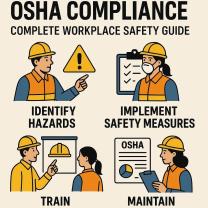What are the basic steps in risk management?
Risk management is a systematic process that involves identifying, assessing, mitigating, and monitoring risks to achieve organizational objectives while minimizing potential negative impacts. Here are the basic steps in risk management:
Identify Risks:
- Begin by identifying potential risks that could affect your organization's objectives. Risks can come from various sources, including internal processes, external factors, and emerging trends.
- Use techniques such as brainstorming, checklists, historical data analysis, and input from employees and stakeholders to identify risks comprehensively.
- Categorize risks into different types, such as strategic, financial, operational, and compliance risks.
Risk Assessment:
- Assess the likelihood and potential impact of identified risks. This step helps prioritize risks based on their significance.
- Consider using qualitative, quantitative, or semi-quantitative methods for risk assessment. Quantitative methods involve assigning numerical values to risks, while qualitative methods use descriptive scales.
- Create a risk assessment matrix or risk heat map to visualize the results of your assessment.
Risk Mitigation and Control:
- Develop risk mitigation strategies to reduce the impact or likelihood of high-priority risks. These strategies may include risk avoidance, risk reduction, risk transfer, or risk acceptance.
- For each risk, create action plans with specific tasks, timelines, and responsible individuals or teams.
- Establish internal controls and procedures to monitor and manage risks on an ongoing basis. Implement preventive and detective controls as needed.
Risk Communication and Reporting:
- Implement a clear and effective risk communication and reporting process. Regularly update key stakeholders, including senior management and the board of directors, on risk-related matters.
- Use clear and concise reporting formats that highlight risk status, trends, and emerging risks.
- Encourage open communication and feedback regarding risks at all levels of the organization.
Monitoring and Review:
- Continuously monitor the effectiveness of risk mitigation measures and control activities. Evaluate whether risks have been reduced to acceptable levels.
- Regularly review and update the risk assessment and mitigation plans to account for changing circumstances and emerging risks.
- Conduct periodic risk assessments and internal audits to assess the overall effectiveness of the risk management process.
Documentation and Recordkeeping:
- Maintain detailed documentation of the entire risk management process, including risk identification, assessment, mitigation plans, and control activities.
- Keep records of risk assessments, action plans, and monitoring activities. Proper documentation helps in accountability and audit trails.
Integration with Decision-Making:
- Integrate risk management into the organization's decision-making processes. Ensure that risk considerations are part of strategic planning, project management, and operational decisions.
- Assess the impact of risks on strategic objectives and make informed decisions based on risk assessments.
Continuous Improvement:
- Foster a culture of continuous improvement in risk management. Learn from past experiences, successes, and failures to refine your approach.
- Periodically review and update your risk management framework to reflect evolving best practices and changing organizational needs.
Training and Education:
- Provide training and education to employees and stakeholders to enhance their understanding of risk management principles and their roles in the process.
- Ensure that key personnel are equipped with the skills and knowledge needed for effective risk management.
External Factors and Compliance:
- Stay informed about external factors, including industry trends, economic conditions, and regulatory changes that could impact your organization.
- Ensure compliance with relevant laws, regulations, and industry standards in your risk management efforts.
By following these basic steps in risk management, organizations can systematically address risks, make informed decisions, and enhance their resilience in the face of uncertainty. Risk management is an ongoing process that requires diligence and adaptability to evolving circumstances.
Basic Phases and Activities in the Risk Management Process
The basic phases and activities in the risk management process are:
1. Risk identification: This involves identifying all of the potential risks that could affect the organization. This can be done through a variety of methods, such as brainstorming, risk workshops, and surveys.
2. Risk assessment: Once the risks have been identified, they need to be assessed to determine their likelihood and impact. This is done by considering the factors that could contribute to the risk occurring and the potential consequences of the risk.
3. Risk treatment: Once the risks have been assessed, the organization needs to develop and implement risk treatment strategies. These strategies can include avoiding the risk, reducing the risk, transferring the risk, or accepting the risk.
4. Risk monitoring and review: The risk management process should be monitored and reviewed on a regular basis to ensure that it is effective and up-to-date. This includes monitoring changes in the organization's environment and identifying new risks.
Core Stages of Risk Identification, Assessment and Response
The core stages of risk identification, assessment and response are:
Risk identification:
- Identify all potential risks, both internal and external.
- Consider all possible sources of risk, including people, processes, systems, and technology.
- Use a variety of methods to identify risks, such as brainstorming, risk workshops, and surveys.
Risk assessment:
- Determine the likelihood and impact of each risk.
- Consider the factors that could contribute to the risk occurring and the potential consequences of the risk.
- Use a risk assessment matrix to prioritize the risks.
Risk response:
- Develop and implement risk treatment strategies for each risk.
- Consider the following options:
- Avoid the risk: Eliminate the activity or process that is creating the risk.
- Reduce the risk: Take steps to make the risk less likely to occur or to reduce its impact.
- Transfer the risk: Transfer the risk to another party, such as an insurance company.
- Accept the risk: Decide to accept the risk and monitor it closely.
Examples of Risk Management Steps in Practice
Here are some examples of risk management steps in practice:
- A company that is developing a new product might conduct a risk assessment to identify potential risks associated with the product launch, such as product delays, technical problems, and marketing challenges. The company could then develop risk treatment strategies to mitigate these risks, such as developing a backup plan in case of product delays and conducting market research to identify potential marketing challenges.
- A bank might conduct a risk assessment to identify potential risks associated with its lending practices, such as credit risk and fraud risk. The bank could then develop risk treatment strategies to mitigate these risks, such as requiring borrowers to meet certain credit criteria and implementing fraud detection measures.
- A hospital might conduct a risk assessment to identify potential risks associated with patient care, such as infection control risks and medication errors. The hospital could then develop risk treatment strategies to mitigate these risks, such as implementing infection control protocols and double-checking medication orders.
Risk management is an important process for all organizations, regardless of size or industry. By following the steps outlined above, organizations can develop and implement an effective risk management process that will help them to manage and mitigate risk.













